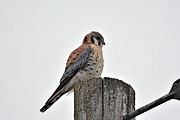American kestrel: Our country’s smallest raptor
Don Bartling | Hagadone News Network | UPDATED 5 years, 8 months AGO
“Hope” is the thing with feathers that perches in the soul. And sings the tune without the words and newer stops-at all.
— Emily Dickinson (1830-1886)
I have been trying to get a picture of an American kestrel since my first sighting five years ago when one landed in my yard above a ponderosa pine. Last week I had my opportunity while driving north on Mirror Lake road west of Bonners Ferry.
The small raptor landed on a telephone pole, anxiously pumping his tail up and down and studying the field below for prey. My camera was ready and I busily clicked away. In an instant he dove to the ground catching a worm and was on to his next perch with his meaty prize.
The American kestrel (Felco sparverius) is the smallest, most common falcon in North America. It has a small, bullet-like head marked with a black and white pattern and moustache-like marks on the sides. The kestrel’s wings are slim and pointed with feathers of blue-grey on males and brown on females. The back of the bird is a reddish-brown color. The Kestrel has a small bullet-like head marked with a black and white pattern and moustache-like marks on the sides.
Kestrels, also known as sparrow hawks, are found throughout Idaho, most of the United States and into Canada. Some northern populations migrate south for the wintertime. This bird is often seen along the edges of fields and roadsides. It prefers semi-open country, such as open fields that border woodlands.
The kestrel has several hunting methods. One is to strike a perched bird by a direct high-speed approach, then if this fails, to pursue the bird in full flight. Another method is to “hover” above prey by facing the wind and rapidly beating its wings. When it is ready to grab its prey, the raptor folds its wings and swoops down to snatch it up in its talons. It will also spend time perched high above fields or roadways watching for prey.
Kestrels hunt mostly mice and large insects, but will also take bats, small snakes, frogs, earthworms and birds. Kestrels are preyed upon by larger raptors including owls, hawks, and other falcons.
Kestrels nest in holes in trees made by flickers, and sometimes in man-made nest boxes. The female incubates her 4-6 eggs for 29-30 days, while the male brings her food. The young birds take their first flight 30-31 days after hatching, but remain dependent on their parents for food until they learn to hunt on their own.
Kestrels have excellent vision which they depend on to be an efficient diurnal, or daytime hunter. Like all raptors the kestrel uses its sharp talons to capture and kill prey. Additionally, it has a curved, pointed beak which is used to tear apart prey into smaller pieces. Although small, this bird exhibits noisy and aggressive behavior towards other raptors to protect its territory.
Falcons are like the race cars of the raptors. The American kestrel can fly horizontally at speeds up to 39 mph. The Peregrine falcon can fly horizontally at 55 mph; however, their dives have been clocked at over 200 mph.
Only 3 percent of Kestrel live longer than 4 years in the wild. The banding record for the American kestrel is 14 years, 8 months.
Enjoy the outdoors and birds in Boundary County.
ARTICLES BY DON BARTLING

Myrtle Falls Trail: A short hike with a spectacular view

Common mullein: An amazing, versatile plant
As I was taking a walk earlier this summer, I noticed along the bank of the Kootenai River some green, soft-looking plants which appeared to be the lambs-ear plant, with which many of us are familiar.

Dog days of summer are upon us
According to Wikipedia “The dog days or dog days of summer (July 22, 2020-Aug. 22, 2020) are the hot, sultry days of summer. They were historically the period following the heliacal rising of the star system Sirius, which Hellenistic astrology connected with heat, drought, sudden thunderstorms, lethargy, fever, mad dogs, and bad luck.”



